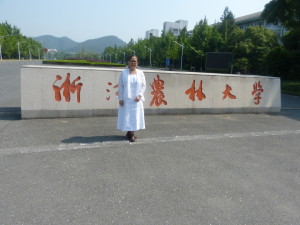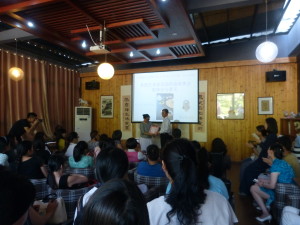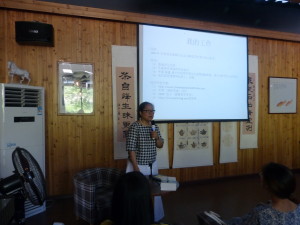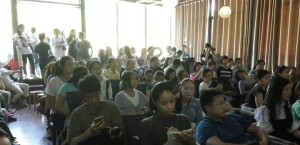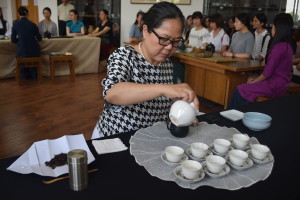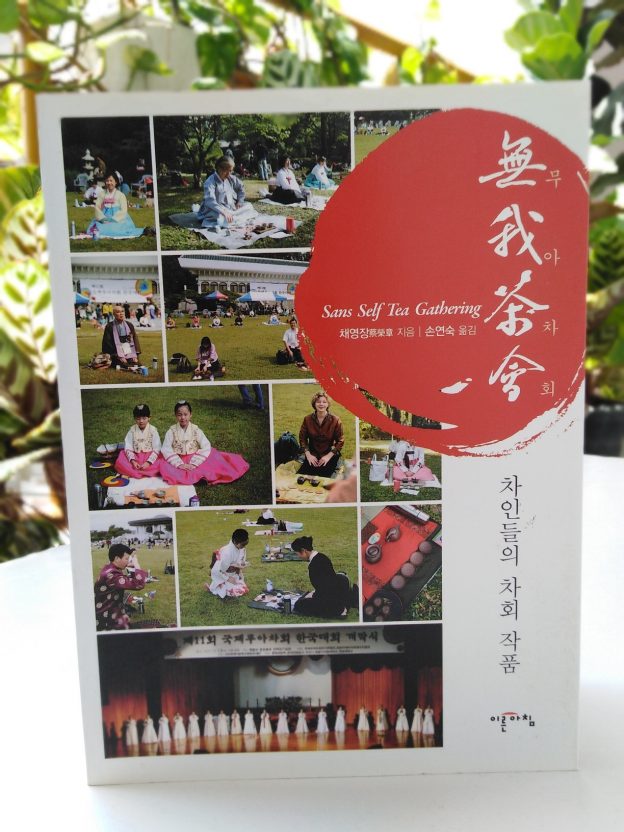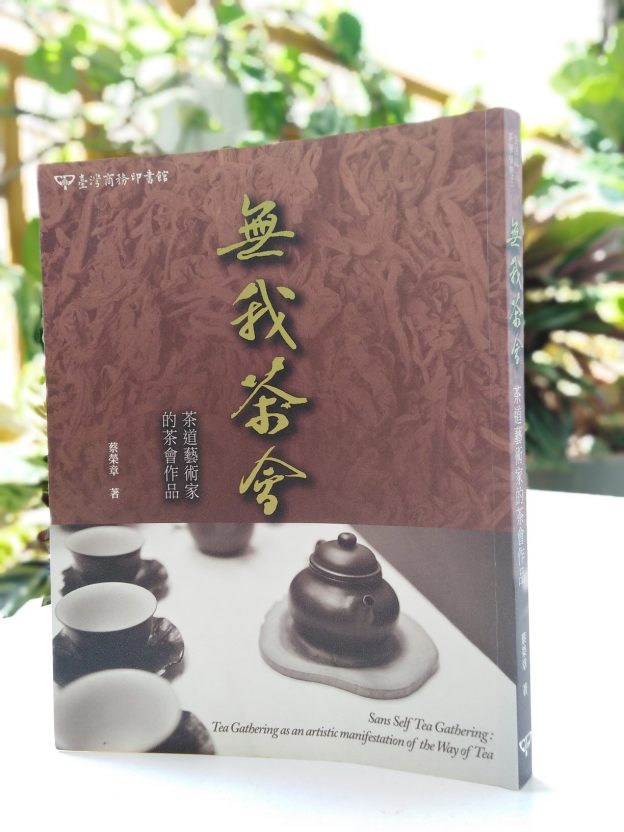《無我茶會Sans Self Tea Gathering (Wu-Wo Tea Ceremony)180條》
蔡荣章著Author:Rong-tsang Tsai
ISBN 978-957-9690-08-9,“无我茶会Sans Self Tea Gathering(Wu-Wo Tea Ceremony) 180” ,First edition: 1999.9, Second edition: 2010.9.《无我茶会180条》,1999.9第一版,2010.9第二版.台北陆羽茶艺股份有限公司.2012.05.20修订版.-English Translator : Katherine Yip,英语翻译:叶德明.
Chapter 10 Problem Solving for Sans Self Tea Gathering(Wu-Wo Tea Ceremony)
128 How do we remedy the situation if an error occurs when tea is served?
Each participant is expected to know all the rules of a Sans Self Tea Gathering by heart. But errors do occur. Rectify the situation where possible if this does not disrupt the progress of the tea gathering. Leave it the way it is if you are not sure how to set it right, or if doing so will undermine the event flow. For example, your fellow participant has misplaced the cup served to you. All you need to do is to gesture him to move the cup back to the right position. This is considered a correctable error. However, if the person has mixed up the person to be served, which is hard to set right without disturbing the progress, then just let it be and consider this an uncorrectable error.
129. What if you are served one cup less?
You may start drinking when you have returned to your place after serving the others, and when your fellow participants have finished serving tea to you. However, if you have waited for an extended period, and there is yet one cup to be filled, then you may want to start drinking to avoid lagging behind. Sometimes, the other party may have taken too much time serving, or he may have simply made a mistake. It is more important to keep pace with the progress.
130. What if I can’t finish pouring the tea I have brewed and there is some left behind?
The amount of water for each brew is determined by the number and size of the cups you have brought along (as well as the ones provided by the organizer for serving onlookers). Calculation has to be done beforehand to ensure there is no surplus or shortage of tea. If the amount of water falls short, or the teapot is too small, then pour a little less tea into each cup. Conversely, if there is too much tea and can’t be finished in one round, then keep it till the next. If there is still some left behind at the end of the last round, just take it yourself.
Some people prefer to bring this surplus infusion home in the thermal flask; the problem is, it is hard to eliminate the smell of tea afterwards. Some people may keep this surplus infusion in the upturned cap of the thermal flask, and pour it away when the tea gathering ends; others may even pour the infusion away there and then if the gathering is held in the countryside. None of these ways are advisable; the fact that you have made an effort to brew well makes the infusion ‘precious’. Discarding it would go against the intention to serve the best brew possible. Just bear in mind that controlling the amount of tea infusion and brew well is very important; should there be any infusion left behind, the best way is to take it yourself.
131. If the tea infusion is too difficult to stomach, what should I do?
When the tea is described as ‘difficult to stomach’, it probably means that the tea is too strong for the palate. If this is the case, and the infusion is bearably strong, just drink it. You may also dilute it with some water if you worry that you body may not be able to take it because of the concentrated strength. If the cup is filled to the brim, you may pour half of the infusion into a cup you have finished drinking from and add water to the infusion.
Such a cup of tea reminds us that we should make it a point to brew well and spare the others of the frustration. In any case, if you have made an effort to bring along the tea, tea ware and hot water for brewing and serving, but come up with a brew that is ‘too difficult to stomach’, it will be a disgrace to not only you but also the tea.
132. If I attend the tea gathering but am not able to take tea on the day, what should I do?
This is rare and very unlikely. Having said that, there may be people who ‘are not tea drinkers but enjoy such an activity’; or, someone may not want to take tea at this juncture out of health considerations. If this is the case, fill each cup with hot water after taking the first brew. This sends the signal to fellow participants that you would not be taking any more tea. If you are not able to take even the first brew, just leave the cups of tea as they are at the original spots. When it time to wipe the cups after the last brew, pour the tea infusion in each cup into the upturned cap of the thermal flask and discard it when the tea gathering is over.
Sans Self Tea Gathering is an activity of tea aficionados that promotes the Way of Tea. A ‘love of tea’ is essential in nurturing an enjoyment of this ‘activity’. If one enjoys the ‘activity’ but lacks a ‘love of tea’, he will be taking away the aura of ‘nothingness’ that makes a Sans Self Tea Gathering so special.
133. What should I do if the previous cup served has not been taken when I am about to serve the second brew?
When you serve with the ‘pitcher’ (or ‘spouted tea bowl’ for powdered tea) after finishing brewing for a second round, you discover that the first cup you served has not been taken. What should you do? At this juncture, observe and decide if the person has yet to do so, or he does not want to take it anymore. If he is about to finish the cup when you show up, you may wait for a little while. If he does not want to drink, then there is no need to offer tea to him. Consider health condition rather than the quality of the brew as the primary reason for his declining the offer.
The situation would have been handled differently if we are serving tea at home. Teachers of the Way of Tea would advise us to ask, “Would you like a cup of freshly-brewed tea?” If your guest agrees to this, pour away the tea which has become cold into the crucible, and refill the cup with some fresh brew. As the spirit and act of ‘frugality’ is embraced by the Sans Self Tea Gatherings, such follow-up offers are not promoted.
134. What if there is still tea infusion in the cup when I come to collect it?
A Sans Self Tea Gathering could be organized in honour of a dedicated person or occasion known as ‘an identified target’, to whom or to which the first cup of the first brew would be offered. One can drink the tea after collecting the cup if the infusion remains not taken at the end of the gathering. For Sans Self Tea Gatherings in general, however, any infusion not taken is considered the responsibility of the person to whom the tea is offered, in the sense that he is the one to clear the teacup of any content even if the tea infusion, for some reasons (such as the brew is too difficult to stomach, too much to finish or being left there out of oversight), remains in the cup when it is time for cup collection. What if the other party has overlooked this rule of a Sans Self Tea Gathering when you turn up to collect the cup? Just take your cup back and pour the infusion into the upturned cap of the thermal flask, and discard it after you have packed the tea ware (you may also pour it away at a suitable spot if the tea gathering is held in the countryside). It pays to find out if it has something to do with poor brewing or other reasons.
135. Is there anything I can do if the tea is not brewed to perfection?
Brewing a good pot of tea is a must for anyone serious about tea. Do the necessary if you notice that the tea infusion is either too strong or too weak before you serve – if the infusion is too weak, you may pour it back into the pot and steep a little longer; if the infusion is too strong, you may add some hot water to the infusion. If the infusion is far too strong and you want to dilute it but the tea pitcher is already full, you may pour a cup first and keep it for yourself. Take others’ tea first, pour half of the strong infusion into one of the emptied cups and add water to dilute.
If you are not sure whether the infusion is too weak or too strong when you pour the tea, you may pour some into your own cup first and try it to make sure it is of the desired strength.
136. If I don’t have enough water for brewing, or there is clearly too little tea infusion, what should I do?
Both scenarios may be attributed to inadequate preparation, or an unexpected increase of cups to be offered to onlookers. When you notice that there is not enough water for brewing during the last round, and there is no supply of hot water on site, you may gently ask the neighbours on your left and right if they have some to spare. If you have finished brewing and discover that there is a lot less infusion than you intend to serve, and the shortage could not be made up by simply having less infusion for each cup, you may need to brew one more time; the amount water would have to be adjusted according to what is needed. In this case, the two rounds of brewing would combine to make one brew.
137. May I offer a cup to my neighbour in the opposite direction?
In the event that there is still some infusion left in the pitcher after serving, you want to know if you could pour some tea into an emptied cup of your neighbour whom you want to get acquainted with but in the opposite direction (for instance, the neighbour to your right, if it is agreed to serve fellow participants to your left). By the same token, you want to know whether you could offer a cup to a senior some distance away whom you want to introduce yourself to. The answer is ‘no’, given the fact that each activity has its own rules and restrictions instrumental to its success.
138. Concerns about hygiene for teacups
Each participant of Sans Self Tea Gathering brings along his own tealeaves and tea ware. At the gathering, everyone brews, and takes tea brewed and offered in teacups by fellow participants. This has prompted some doubt about hygiene. Some people have come up with ideas about alternative arrangement. They suggest that one’s teacups be placed at one’s own ‘tea serving area’, and fellow participants pour tea into the teacups using tea pitchers (or spouted tea bowls). While this may allay worries about ‘the cleanliness of others’ teacups’; it will nonetheless create unnecessary distance among participants which should not be the case. Come to think about it, human interaction is not as clinically hygienic as we imagine it to be – we shake hands with each other and we hug each other ever so often. What Sans Self Tea Gathering advocates is a natural and truthful flow of feeling among individuals; and hence the particular way of tea serving. Having said that, we should make sure the cups, tea ware, our hands and body are clean before attending the tea gathering. Equally important are quality tealeaves and clean water for brewing. At the tea gathering, we use the best of our knowledge and skill in brewing a good pot. Not to be forgotten is a pleasant disposition and positive mindset to make you a great person to be with.
139. Could we find out the name of the tea we are served? And utter some words of praise if appropriate?
Sans Self Tea Gathering is to proceed in silence and no one should speak. As such, you should not try to find out what kind of tealeaves it is when you are enjoying the tea. But it would be hard to have the question hovering in your mind throughout the event, wouldn’t it? This is why you should focus on the brew without bothering about its name. Likewise, when we offer tea to, say, the first, third and fifth fellow participants to our left, we do not need to know their names. We do not need to know the name of the mountain to appreciate its grandeur, nor the name of the cloud to appreciate its ethereal beauty. But if you just happen to know that the cup of tea was brewed by a certain participant, it is acceptable for you approach him after the tea gathering and find out more about his brew. Furthermore, if the brew is a very good one, it is perfectly fine to let the person know by way of praising. Tea drinking will become a chore if you keep bothering yourself about the name of the brew and its respective brewer, or reminding yourself how poor the brew is.
140. After offering the last brew, would it be possible for me to approach the tea guru I revere for his brew?
There were past incidents where participants went up to meet a certain tea guru after offering the last brew. It might have started with just one participant, but before long, others followed suit until the crowd disrupted the procedure of the rest of the tea gathering. This was brought up during the post-event review, and it was felt that such disruption should be stopped. It is understood that the opportunities to get up close and personal with famed tea gurus may be difficult to come by; but this is best done during the ‘tea ware appreciation and networking’ session, or the ‘post-event activities’. One should bear in mind that in this case, reverence shown to some could be the cause of suffering, inconvenience and unpleasant experience of the others. This is certainly what tea aficionados would not want to happen.
141. Is it fine to exchange tea ware with fellow participants at the end of the tea gathering?
At the end of the Sans Self Tea Gatherings held over the past few years, some participants were seen exchanging tea ware as mementoes. At the beginning of the post-event review session, some people thought this was quite meaningful, especially for tea gatherings with international participants. As the discussion progressed, there were more and more opposing voices — they worried that if this becomes a trend, participants would have to make great mental effort in choosing the tea ware in case they need to exchange it with fellow participants. While tea ware which has long been in one’s possession may not be highly-priced physically, it could have great emotional value, and the possibility of parting with it during a tea gathering could put one in distress. With this in mind, it is agreed that there should not be any exchange of tea ware during a Sans Self Tea Gathering.
142. Is it permissible to ask a few friends to stay back for more brews when the tea gathering is over?
Seating arrangement of a Sans Self Tea Gathering is decided by random drawing. As a result, friends and old acquaintances may not be sitting next to each other. Some of them tend to stay back after the tea gathering and continue to make more tea together. This may create the impression that they only enjoy each other’s company and were forced to offer tea to other participants just now.
It is natural that people sit with their friends if not for seating arrangement by random drawing; for international events, people from the same country or region will certainly frock together. And yet, this would not have any contribution to the spirit of a Sans Self Tea Gathering. The tea gathering may be a picture of harmony free from national divides, ideological differences and personal relationship; but the small circles emerged after the event would surely defeat the purpose of a tea gathering that is supposed to be ‘san self’. Considering this, the organizer would not approve of any self-formed groups staying behind for more brews.
143. Is beverage other than tea allowed during Sans Self Tea Gatherings?
A ‘Sans Self Tea Gathering’ is the expression of the unique characteristics of ‘tea’ in the form of a tea gathering. It is certainly not an occasion that picks ‘tea’ as the beverage of choice. To fully appreciate the spirit of a ‘Sans Self Tea Gathering’, the ‘love of tea’ is imperative. It will be superficial and manipulative if one adopts its format and rules without the tea.
As such, non-tea beverage is not advisable. However, there is no restriction as to the type of tea used, and whether it is flavoured or floral-scented.
(2114)
 不要只是为了办活动才参加无我茶会/文/蔡荣章/20180208
不要只是为了办活动才参加无我茶会/文/蔡荣章/20180208


